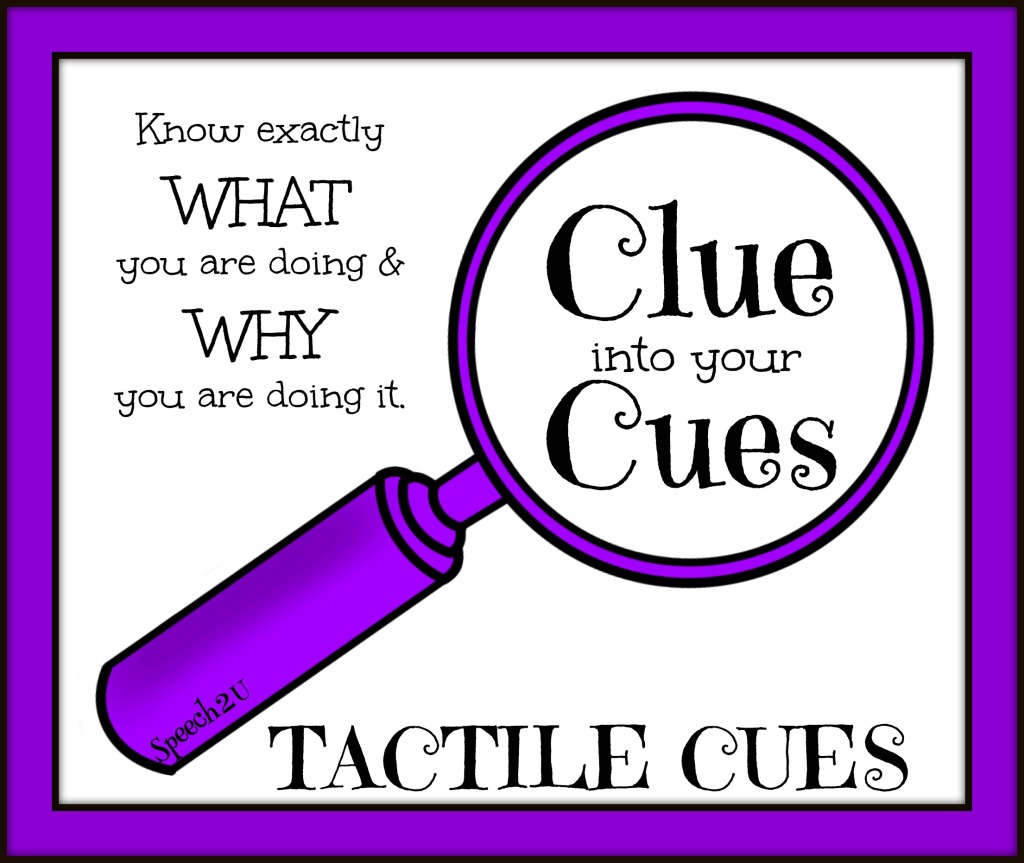I started talking about this last month-and then got a little distracted with the holidays. My topic of the month for November and December is cues/prompts. I’m using them interchangeably but I realize that many people do make distinctions between the two but I don’t. Maybe I’ll form my own island and have my own rules about other things soon too. Cues and prompts are part of our skilled service-it’s why WE need to see a child vs. a parent, tutor, teacher or para professional. I think it is really easy to forget ALL of the things that we do to help our clients and students succeed. After you do therapy for awhile, it starts to seem so routine that we think anyone could do it.
Today I am going to talk about tactile cues or physical prompts. I think OT and PT tend to use tactile cues more frequently but used correctly they can be very effective-especially for clients with motor learning challenges. As with my post on verbal cues, I am going to try to give examples for how I might use tactile cues to teach a variety of language and speech targets.
- Articulation: Saying an initial /b/ sound
- Syntax: Using regular past tense -ed
- AAC: Have a student tell you to “turn on” radio to listen to music.
- Pragmatic language: Greet another student
- Receptive language: Identify objects by function
- Vocabulary: Define a vocabulary word by category and function.
Hand over hand cues: We use these prompts when we need to physically guide the child through the entire task.
- Articulation: Don’t you wish that we could just get inside of a client or child like a puppet to help them make their sounds? I know I have some parents who may think we can do this. I don’t know of any hand over hand cues that would be appropriate here. The closest I can think of would be for people who are PROMPT trained. The first level of cues (parameter prompts) helps to shape jaw height or lip rounding/spreading for sound production.
- Syntax: As with articulation, there isn’t a great option for hand over hand cues.
- AAC: Move your clients hand to the buttons turn and on to help them push it.
- Pragmatic language: You could physically assist the child in waving to greet a friend.
- Receptive language: Move the child’s hand over to touch the object function you are targeting.
- Vocabulary: You could work receptively to have the child point or touch a category or function by helping them to point to the correct picture.
Partial Physical Cues: We use these cues when we only need to guide the child towards the correct response, but don’t need to physically assist them with the whole
- Articulation: You could help move the bottom lip up with your thumb while pushing up and in and then releasing to simulate the plosive nature of /b/.
- Syntax: I’m not sure that there is a partial physical cue that I would use to teach syntax.
- AAC: Move your client’s arm towards the AAC device or button that you want them to press.
- Pragmatic language: Lift the clients arm up and wait for them to initiate a wave.
- Receptive language: Move the client’s arm towards the picture you want to touch.
- Vocabulary: You could work receptively to have the child point or touch a category or function by guiding them by the elbow towards the picture you want them to touch.
Tactile Cues:
- Articulation: Touch the lips and release at the lips to let them know they need to make the /b/ sound.
- Syntax: I use tactile cues when teaching morphology. For instance, if I am teaching regular past tense -ed, I may place my hand on the student’s arm as I start the sentence, “Yesterday, he walkED.” I press in a little bit on the “ed” to help them pay attention to the ending. I use the same thing for auxiliaries.
- AAC: You could touch their arm to let them know that there is something they could do.
- Pragmatic language: Similar to above, you could touch the client’s hand to let them know that they could wave to greet someone.
- Receptive language: These are all kind of the same. You could give them a tactile cue to let them know that there is something they need to do. I would probably use a physical prompt or hand over hand. I’m not sure how often I would use a general tactile cue to teach these skills.
- Vocabulary: If you had set up hand signals to cue for category/function, you could touch their hand or start to shape it into the hand signal. (For me, I use my hands above my head in a circle to indicate category. We pretend to hammer to indicate function).
In general, I think of physical cues and more intense than verbal or gestural cues but it depends. For instance, it’s probably less of a cue to touch the lips to cue /b/ vs. saying, “Look at my lips, put your lips together blow the air out and say “BAH”” while giving gestural cues. Kids who have motor planning deficits benefit from being able to feel what they are supposed to do (vs. being shown or told).
A few additional considerations when talking about physical cues. You can grade your level of support by varying the amount of pressure you provide, changing the amount of body contact (do you use your whole hand or just a finger.)
What physical cues did I forget? I’d love to hear about your tricks below!



I really love this series! I am printing a copy for me and one for the grad student working with me this year. Thank you!
Thank you Jennifer!